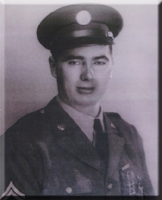
Robert Cahow's Story ...
The eldest of eight brothers from a farming community in Clear Lake, Wisconsin, Robert Cahow was originally drafted earlier in WW2. He'd been an MP, guarding POW's in America. He volunteered for frontline duty, as he wanted to serve his country in a more active manner.
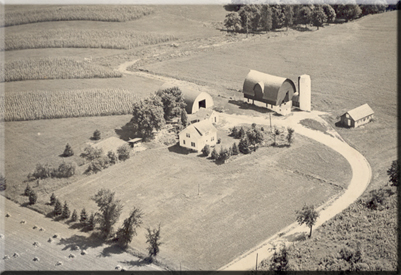 The Wisconsin Farm where Robert was born in 1916
The Wisconsin Farm where Robert was born in 1916On December 13th 1944 soldiers of the USA 78th Infantry Division went into action in the Hürtgenwald. The Germans called it "Die Totenfabrik" or Death Factory and with good reason. The 78th Infantry Division was known as the "Lightning" Division on account of their lightning bolt shoulder patch. The Division was made up of the 309th, 310th and 311th Infantry Regiments. In the 311th was a Private First Class Robert Cahow, his Army number was 36206366 and he had originally joined the Army in Wisconsin. Being 6 foot 7 inches tall Robert stood out from his comrades. The units target was Schmidt, the elusive objective for the 28th Infantry Division during the fighting in November 1944. Robert and his comrades were in action against elements of the 272nd Volksgrenadier Division. This unit had been in action several weeks and was in theory supposed to be preparing for the Wacht am Rhein offensive (the Battle of the Bulge).
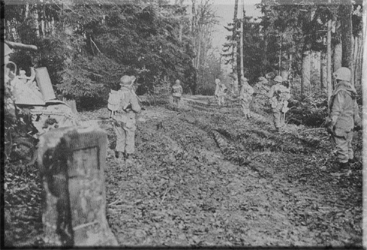 the Hürtgenforest ... "Die Totenfabrik"
the Hürtgenforest ... "Die Totenfabrik"On December 13th 1944 Company K was assigned to execute a diversionary assault on a bunker in the forest. Many of the soldiers in Company K were new to combat. Anti-personnel mines and enemy fire killed and wounded many. Several men volunteered to recover the wounded, Robert Cahow was one such volunteer.
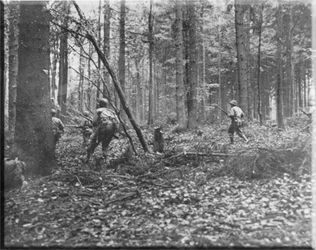 Advancing through hostile terrain ...
Advancing through hostile terrain ...His friend Harvey Jorgensen was another. Jorgensen recalls: "We made our way slowly through the shattered undergrowth, snow falling steadily. We were spaced about 50-75 yards apart so as not to alert the Germans, who were all around in trenches and log emplacements. At once the silence was shattered by a detonation. Robert had hit a booby trap". The resulting fire from the alarmed Germans threw the survivors back. The confusion that followed meant that Jorgensen and his comrades couldn't locate Robert. Later the Germans found and buried him near the bunker that had been his units objective. Robert Cahow was listed Missing in Action ... he would be for another 56 years ... The Ardennes offensive opened on December 16th 1944 and the fighting in the Hürtgen forest was sidelined by events further south in the Ardennes.
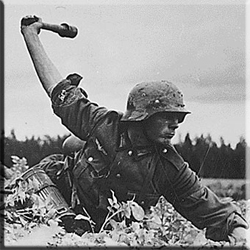 "the Germans, who were all around in trenches and log emplacements"
"the Germans, who were all around in trenches and log emplacements"The Cahow farm was about 10 miles from the nearest telegraph office. In late December, 1944 Gilbert Nelson the telegrapher in Clear Lake received a telegram from the War Department. At that time messages were often delivered via telegrams. Quite often the telegram would be delivered by the local postman or a telephone call would be made to the receiving party.
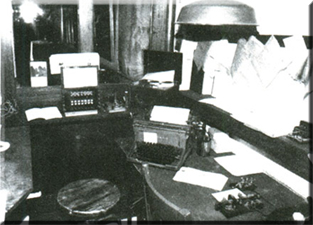 telegraph offices received telegram's from the War Department
telegraph offices received telegram's from the War Department That is what happened in the case of PFC Robert Cahow. The three youngest brothers: Harold, Adam and Douglas plus Clifford our father were in the barn doing the morning chores when Syneva Cahow (our mother) came to the barn to inform Clifford there was a telephone message from Gilbert Nelson who had a telegram message for Clifford. Everyone of the Cahows knew Mr Nelson was the telegrapher and a telegram from the War Department was usually tragic news.
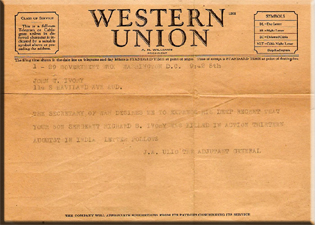 "a telegram from the War Department was usually tragic news"
"a telegram from the War Department was usually tragic news"Clifford instructed his 3 sons to stay in the barn while he made the 100 yard trip to the house. The Cahows were on a party line so usually several other persons listened into the "private" conversations which seemed a common pastime in rural areas. And it wasn't long before the news of the impending tragedy spead through the neighborhood.
While Clifford was gone to the house, Harold who was 17 years at the time, tried to inform his younger brothers Adam 14 and Douglas 11 years just what was going on. In spite of our youth, we knew exactly all about the war in Europe. We listened to the news daily, read the newspapers religiously, and in addition nearly every neighbor had a brother or loved one in the military so the war was a common topic for us every day.
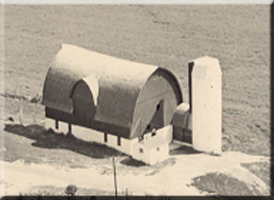 "Clifford instructed his 3 sons to stay in the barn"
"Clifford instructed his 3 sons to stay in the barn"Several minutes passed and the longer Clifford was gone the deeper the horror of what could or had happened to our older brother began to fill our minds with an impending tragedy. Clifford was gone for what seemed like an eternity for the 3 younger siblings of Robert. Why was this telephone conversation taking so long? We learned later he had taken time to be with his grief stricken wife who was at his side when the news of Robert came via the telephone. We tried reassure our selves that there was a mistake why dad was getting this telephone message or any number of other calibrated possibilities. Many neighboring men had already been killed or wounded and the chance that such a tragedy had happened to Robert was the utmost possibility!
Eventually father returned to the barn and his face was ashen and tears were in eyes. He didn't have to say anything because we knew something tragically had happened to our oldest brother. Dad, as we called him, collected his strength and in his simple but 3d grade education manner began to tell us what we feared most ... Bob was MIA!
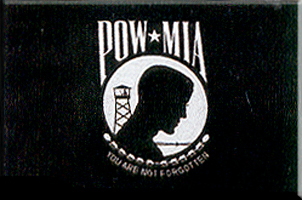 "what we feared most ... Bob was MIA"
"what we feared most ... Bob was MIA"As young boys we did not fathom the meaning of MIA other than to know it meant something awfully bad for our family. Dad went on and recounted as best he could what the telegram from the War Department said. It made no difference to us that there was hope built into the message because there had been too many horror stories about neighboring men who whose airplane had been shot down, their ship sunk, or someone being captured and placed in a POW camp to die of inhumane treatment. We knew all of those stories and we were certain that only the worst had happened to our oldest and beloved brother.
The memory of that moment in 1944 is still burning in my mind in 2006 and tragically mother was left in the house alone to weep for her first born. Dad was trying to be brave and give mental and spiritual strength to his sons and so was brother Harold . However, soon his bravery turned into that of an enraged man of 17 years. I vividly recall him lashing out to whomever would listen and vowing to enlist immediately and go to Europe and kill every German soldier he could find. But since he was a juvenile, he had to wait until his 18th birthday to eventually enlist in the Navy.
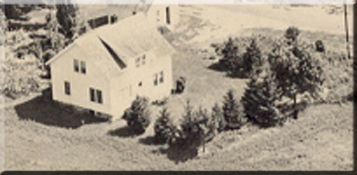 "mother was left in the house alone to weep for her first born"
"mother was left in the house alone to weep for her first born"The horror of that moment lingered for several hours and finally, dad said to his boys that we had to finish the chores ... our cattle had to be cared for too. Such was the life of farm folk who depended on livestock for their welfare. If there is lesson to be learned by that fateful event it is that our tragedy must be faced and the survival of our family was important too.
So from that late December, 1944 date until December 13, 1945 another message came from the War Department stating Robert was officially KIA on DECEMBER 13, 1944! After a Memorial service in early 1946 the Cahow family went about their lives. William had been wounded in Germany and crippled for life, Raymond spent over a year fighting the Japanese in the Pacific, Harold joined the navy when he was 18, Adam joined the Navy in 1951 and Douglas joined the army in 1953. 2 brothers could not pass the medical physical and were never in the service.
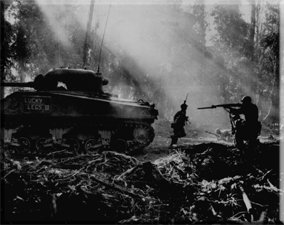 "Raymond spent over a year fighting the Japanese in the Pacific"
"Raymond spent over a year fighting the Japanese in the Pacific"As the years passed the memory of Robert lingered still ...but there was no word of hope or any kind of evidence as to what happened to PFC Cahow. Their other brother William came home from the war with a leg wound. (He'd been in the 628th Tank Destroyer Battalion and fought right up the May '45). Lives changed and as the Cahow brothers went on with their individual lives, Clifford died as result of a car accident in 1958, Gordon died in 1965, Mother died in 1982, Donald did the same in 1985. Both parents and 2 brothers went to their graves without knowing what happened Robert ... but the memory of PFC Robert Cahow who was reported MIA on December 13, 1944 is now history because his beautiful story of love, devotion and sacrifice live today in web pages, pictures, memories, and history books .
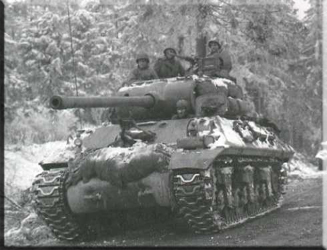 a M-10 Tank Destroyer
a M-10 Tank DestroyerIn April 2000 German engineers were clearing the forest area around Vossenack prior to returning it to farmland. Remains of an American soldier were found, nearby two German soldiers. The Americans ID disks appeared to read Robert Cahon, but research and examination of the disks and the physical size of the remains implied this was a giant of a man, 6 feet 7 inches tall ... Robert had been found.
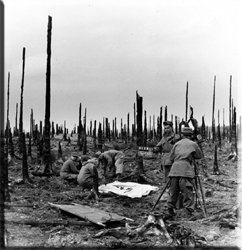 recovery of American bodies in the Hürtgenforest (1948)
recovery of American bodies in the Hürtgenforest (1948)The church service was run largely by the Cahow family. Nieces of the fallen Cahow sang "How Great Thou Art," one of them, SPC Lynda Porter of the Minnesota National Guard, singing in full dress greens. Brother Adam told the story of how Robert had died in the cold, dark vicious battle of the Huertgen Forest. Nephew Scott and another niece named Linda read the 1945 obituary. Brother Douglas recounted the last time he saw his brother, whose 6'7" frame and genial nature had him known to all as a "gentle giant," saying, "He came home on leave before departing to fight in Germany, a mission for which he'd volunteered, despite having a comparatively safe assignment stateside guarding Prisoners of War. He helped Dad in the field, and I can still in my mind's eye see that tall frame stooping to pick corn and lay it in the wagon drawn by our horses."
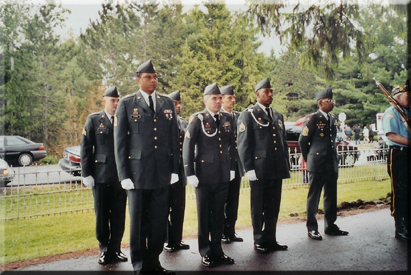 the Color Guard at Robert's funeral
the Color Guard at Robert's funeralRobert's remains, in an open casket at the front of the packed church, were wrapped in an Army blanket, and his dress green uniform, complete with the 78th Division Lightning patch, Combat Infantry Badge, Bronze Star Medal with "V" device, Purple Heart, and other medals he had earned, lay atop. A black and white photograph of him in all his youthful glory and height, serving as a Military Policeman, stood on the top of the gleaming wooden casket. The Stars and Stripes adorned the bottom half, and at the end of the service, the 78th Division honor guard tenderly closed the coffin, draping the bright colors fully along its length. With solemn dignity and pride, they carried it from the church, down a long gauntlet of color bearers standing at proud attention, which included many local and state Veteran of Foreign Wars and American Legion units. The hearse was followed to the cemetery by hundreds of cars.
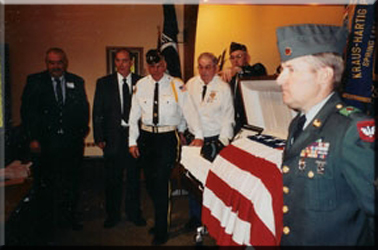 "Robert's remains, in an open casket at the front of the packed church ..."
"Robert's remains, in an open casket at the front of the packed church ..."The graveside ceremony was opened by a family friend, Daniel Ponath, member of a local American Legion unit, who played the heartbreakingly beautiful trumpet solo "The Lord's Prayer," with tenderness and skill. A gentle, fine mist of rain appropriately set the mood for the service, but did not mask the genuine tears on many onlookers' faces. Town dignitaries spoke against a backdrop of the Nation's flags, all, from Old Glory down through the service flags to the POW/MIA flag, at half-staff.
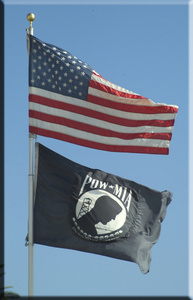 the Stars & Stripes and the POW/MIA flag
the Stars & Stripes and the POW/MIA flagThe Interment service is recounted here by Cpt. Laura Kenney of the present day Lightning Division. The chill sound of "Taps" wafted over the cemetery as 78th Division WWII veteran Cpl Robert T. Cahow, listed as Missing in Action for fifty-six years, was finally laid to rest. The bugle was played by Cahow's nephew and namesake, Cpl Robert Cahow, Wisconsin National Guard, during the internment ceremony that fittingly took place during the Memorial Day weekend. Even more appropriately, Cahow was accompanied to his grave by a contingent of 78th Division soldiers from the same unit he fought and died with, so many years ago. These young soldiers of today's 3/311th Regiment stepped proudly, and felt the honour keenly, as they escorted and carried the casket of their fallen comrade to its final resting place. The six soldiers: SFC Tony Mitchell, SFC Sean Lucas, SFC Franklin Fayson, SSG Alphonso Hilton, SGT Robert Copeland, SGT Micheal Guyette, were led by CSM Joseph Robertson.
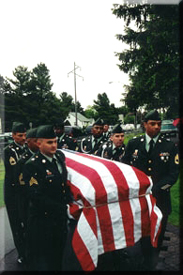 "they escorted and carried the casket of their fallen comrade"
"they escorted and carried the casket of their fallen comrade"Col. John McLean, 78th Division Historian, who had been instrumental in identifying Cahow as a 78th Division veteran served as the Officer in Charge of the funeral detail. The ceremony took place in Cahow's home town of Clear Lake, Wisonsin, population 942. At least two/thirds of that population attended the service. Numerous 78th Division WWII veterans, also attended in order to honour their fallen comrade. One such veteran, CW4 William Elwood, sought and received permission from the Association to fly to Hawaii - where the Army's forensic laboratory for identifying remains is located - and serve as the 78th Division Association official honor guard to escort Cahow's remains home.
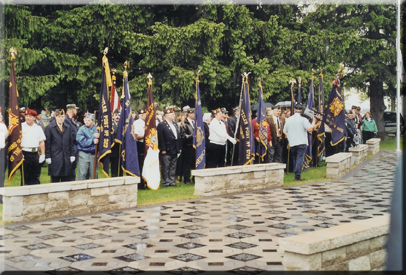 "Numerous 78th Division WWII veterans, also attended"
"Numerous 78th Division WWII veterans, also attended"Elwood did so at his own expense, and said "Robert deserved it....he fought and died for our country ... I was lucky, I just fought, and in gratitude for his sacrifice, I felt I had to make that journey." The five surviving Cahow brothers, who had never rested in their fifty-six year- long-attempt to find out what had happened to their brother, were finally able to say goodbye properly, and lay him to rest near a beautiful memorial to all the veterans from Clear Lake who had made the ultimate sacrifice. The memorial had been built entirely with funds generated by the small town, and the youngest of the brothers, Douglas, had been the primary mover in its inception and raising. Of the seven brothers, five served either in WWII or Korea.
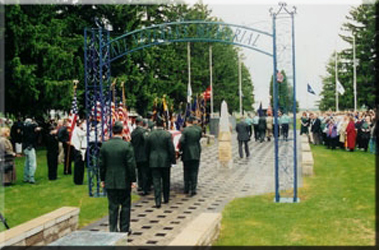 the Clear Lake All Veterans Memorial
the Clear Lake All Veterans MemorialAt the end of the spoken memorials, the 78th Division contingent respectfully and crisply folded the colors resting on the casket, and presented them to McLean, who wheeled sharply, and with precision, marching to the first in line of the Cahow brothers. Douglas, in his VFW hat, with tears unashamedly tracing his cheeks, accepted the flag that had draped his brother's coffin. Each brother in turn was presented with a folded flag in wooden case.
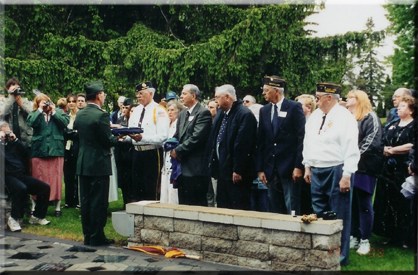 "Douglas ... accepted the flag that had draped his brother's coffin"
"Douglas ... accepted the flag that had draped his brother's coffin"Then a three-volley gun salute by representatives of Ft. Leonard Wood, Missouri. The five brothers, Douglas, Adam, William, Harold, and Raymond stood, bareheaded in the rain, holding their flags, as Robert's casket was lowered into the dark, moist earth ... Finally Robert was back home, where he belonged ...
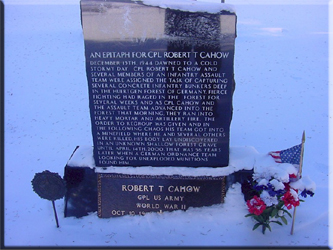 Robert Cahow's final resting place in Clear Lake
Robert Cahow's final resting place in Clear LakeThe memorial to Robert Cahow that was unveiled in 2001 on the spot where he was discovered. It was only chance that he was found. A German ordnance recovery team having detected the live grenades that he had been carrying. We understand that two German soldiers found nearby have also been identified and given proper burials in the nearby war cemetery.
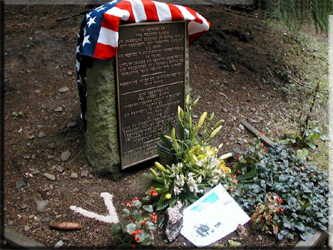 the memorial for Robert Cahow in the Hürtgenforest
the memorial for Robert Cahow in the HürtgenforestIn June 2002 Douglas Cahow paid an emotional visit to the site of his brothers death in combat in the green hell that was the battle of the Hürtgenwald. Pictured below is Doug. He has draped his Legion jacket and hat over the simple wooden cross (Doug is a veteran of another war - Korea).
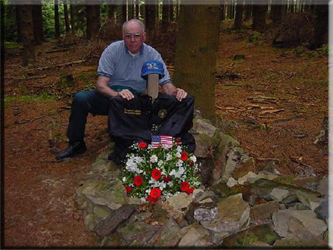 Doug Cahow at the place where Robert was recovered
Doug Cahow at the place where Robert was recoveredParts of the story are from Simon Lerenfort's website: http://www.lerenfort.fsnet.co.uk
published, May 22, 2006